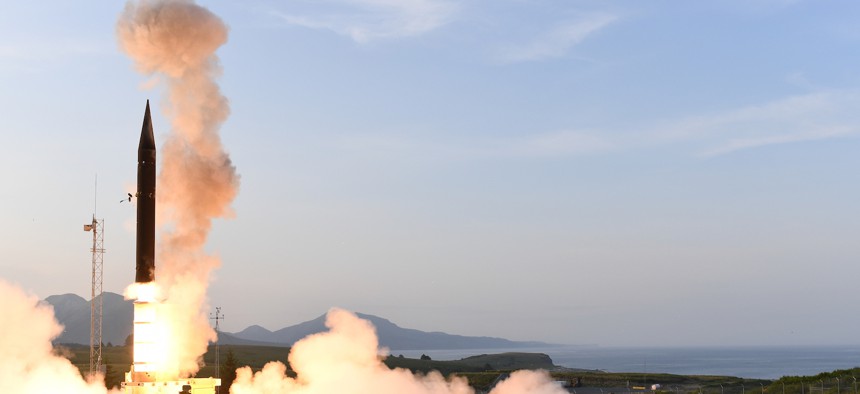
The Israel Missile Defense Organization (IMDO) of the Directorate of Defense Research and Development (DDR&D) and the U.S. Missile Defense Agency (MDA) completed a successful flight test campaign with the Arrow-3 Interceptor missile. Missile Defense Agency
US Missile Defenses Are About to Level Up
Laser-armed Strykers, new Eastern European batteries, and sea-based interceptors are all coming in the next two years, Pentagon officials say.
Over the next two years, the U.S. military expects to stand up its first "laser battalion," demonstrate that sailors can knock down ICBMs with missiles fired from surface ships, and establish two counter-Russian missile defense sites in Eastern Europe.
It’s all part of a series of soon-to-come innovations in missile defense aimed at deterring Russia, China, Iran, or any other adversary, outlined at the virtual Space Missile Defense symposium on Tuesday.
Among the key ones is the Maneuver Short-Range Air Defense, or MSHORAD, basically a Stryker vehicle outfitted with anti-missile defenses, including the laser-equipped DE-MSHORAD. “Expect to have the first battalion fielded in 2021 with four battalions by 2023,” Lt. Gen. Dan Karbler, commander of the U.S. Army Space and Missile Defense Command, told the audience.
Lt. Gen. L. Neil Thurgood, director for Hypersonics, Directed Energy, Space and Rapid Acquisition in the Office of the Assistant Secretary of the Army, said that the 50kw laser-mounted Stryker was coming in 2022. The service is also working on a 200kw truck-mounted laser dubbed IFPC-HEL that Thurgood said would be deployable (although not necessarily deployed) with platoons in 2024. By the next year, the Army wants to field an even more powerful laser, the 300kw Indirect Fire Protection Capability-High Energy Laser, or IFPC-HEL.
The Army also wants to outfit maneuvering units with mobile microwave weapons, which, Thurgood said, are more useful against drone swarms than lasers, as microwaves can destroy the electronics of more targets at once. But directed microwaves, built at scale, don’t fit easily on a truck. Scientists are reducing the size and weight and making this more feasible.
The Pentagon’s Missile Defense Agency hopes that by the end of next year in Europe, a new Aegis Ashore missile interceptor site will have been completed in Poland (after delays due, in part, to COVID-19). “We are seeing an uptick in terms of the Army Corps construction,” said Adm. Jon Hill, director of the Missile Defense Agency. “We’re really going to go hot in 2021” toward a projected 2022 completion.
Next year will also see the Navy test its ability to down ICBMs with SM-3 missiles fired from an Aegis destroyer and guided by off-ship radar via the Sea-Based Weapons System, or SBWS, Hill said.
MDA and the Navy also will test the SBWS against a medium-range ballistic missile, and in a separate test against two separate short-range ballistic missiles, he said.
Next year will also mark a key one for the new next-generation interceptor program, an effort to build new missiles capable of hitting more advanced ICBMs that deploy decoys or multiple warheads. MDA went back to the drawing board on the project last August, canceling the program. It drafted a new request and in May Northrop Grumman announced that it was partnering with Raytheon Missiles & Defense to offer a new interceptor.
MDA has “paused” its program to design an interceptor that could take out hypersonic missiles, Hill said, to look at near-term options. But the hypersonic threat is only building. That means that a new request could emerge next year, which could speak to the feasibility of different concepts for countering hypersonic missiles.
All of this activity reflects the growing importance the U.S is placing on deterring and defending against missile proliferation worldwide. Congress put missile defense under the defense undersecretary for research and engineering in 2018. MDA's budget requests and appropriations have shrunk as services have taken on more of the “missile defense” role for themselves.
New missiles and missile defense technology are highly desired by U.S. allies in Europe, the Middle East, and Asia, as Russia, Iran, China and others have armed with the fast and low flying weapons, some threatening to top them with nuclear warheads, and as arms control agreements have expired or are set to, shortly. At the end of July, for instance, Russia announced that nuclear-armed hypersonic missiles would be deployed aboard ships.





